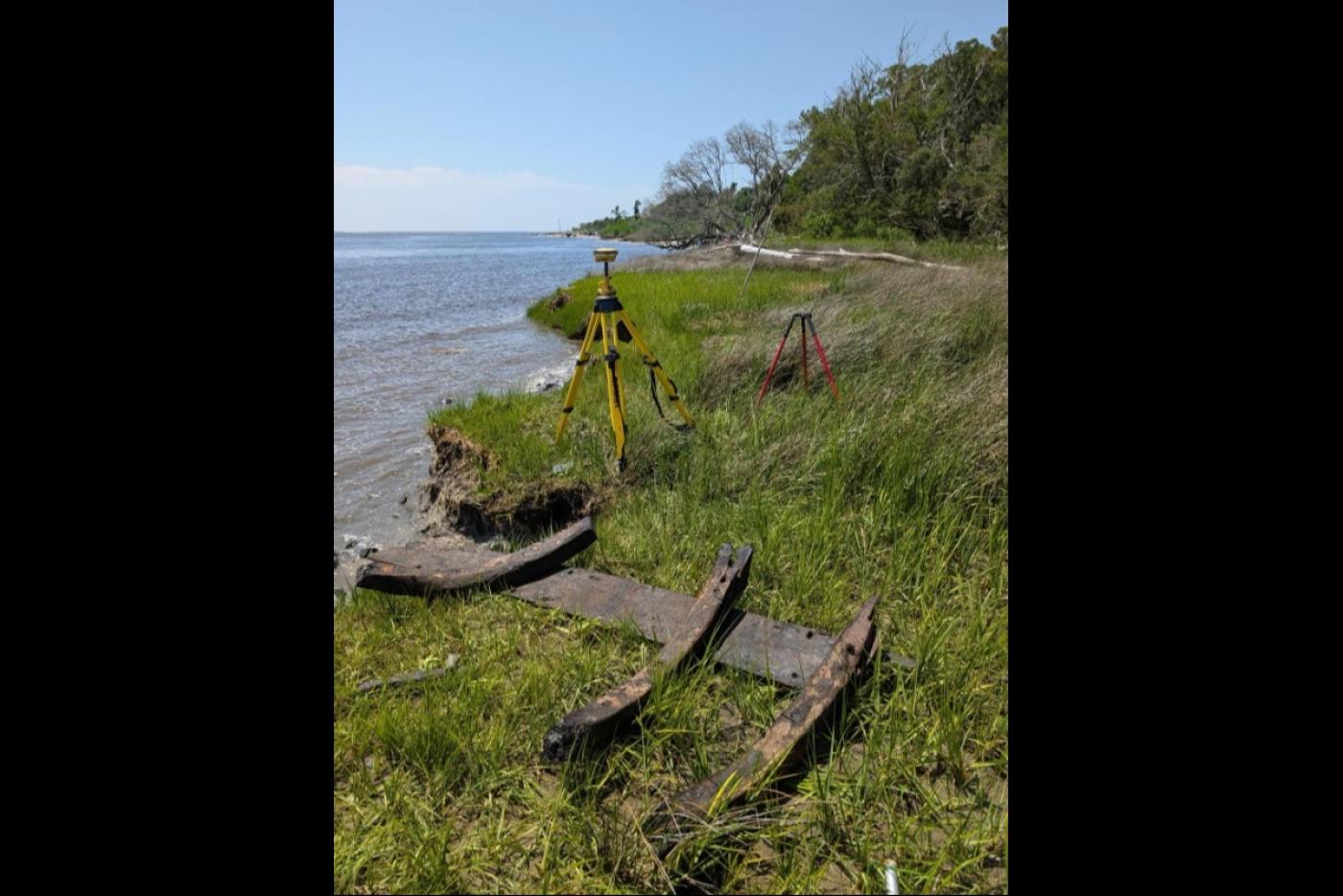Earlier this month, East Carolina University (ECU) announced the discovery of four at-risk shipwrecks on the colonial waterfront at Brunswick Town-Fort Anderson State Historic Site (BTFA), including the possible remains of the 1748 Spanish privateer, La Fortuna.
The remarkable findings are the result of an ongoing partnership between ECU and three programs administered by the N.C. Department of Natural and Cultural Resources: the Office of State Archaeology (OSA) Underwater Archaeology Branch (UAB), Queen Anne’s Revenge Conservation Laboratory (QAR Lab), and the Division of State Historic Sites. But once a discovery of this magnitude is made, what comes next?
ECU will continue to study and record the shipwrecks while experts at the QAR Lab in Greenville, N.C., will oversee the monumental task of storing and preserving the remains that were collected during this summer’s three-week field school. In total, the team recovered 63 shipwreck timbers. This accounts for roughly 35 frames, 26 planks, one knee, and one sprit (used for extending the length of a sail beyond the width of the deck). Most of the timbers can be accurately attributed to the remains believed to be La Fortuna.
“Much work lies ahead as we continue to find out more about this chapter of Brunswick’s history, but we look forward to the new challenges and opportunities that will accompany this incredibly significant discovery,” said Deputy State Archaeologist Stephen Atkinson. “The preservation and interpretation of findings like this help us further understand North Carolina’s history and the role of early colonial sites in shaping our country’s future.”
At Brunswick Town-Fort Anderson, site staff are already thinking carefully about how the discovery will further inform interpretation of the history of La Fortuna and the Spanish attack on the town. A new special focus tour is under development and will debut in September to align with the 277th anniversary of the ship’s demise.
Persistence and Cooperation Pay Off
UAB staff, along with archaeologists and students from ECU’s Program in Maritime Studies, have been studying the BTFA waterfront together since 2021. Guided by BTFA site manager Jim McKee’s in-depth research of historic maps and archival sources, UAB helped provide ECU’s maritime studies students with hands-on experience in shoreline remote sensing. Together, the research and data suggested that significant historical resources likely remained submerged in the area and warranted further study.
In 2024, the field school team made a breakthrough discovery by confirming evidence of colonial wharfs, finding casks, bottles, and the base of a punch bowl. When Atkinson found a lone timber that washed ashore on the southern end of the waterfront, he suspected the presence of a shipwreck nearby. His suspicions were confirmed when Maritime Studies graduate student Cory van Hees stumbled across a series of frames protruding from the river bottom. UAB provided critical resources for a staging area and field lab, as well as vessel and diving support to aid the ongoing efforts.
The 2025 field school planned to explore that wreck in depth but realized upon arrival at the Brunswick Town waterfront that immediate action was needed. In the span of a year, significant sections of the shoreline had washed away, causing the wreck to become dislodged. To their alarm, pieces of the ship lay scattered along the shore. Weighing the costs and understanding the work that would lie ahead, Atkinson and UAB staff made the call to recover the wreck entirely. They constructed a temporary artifact holding tank at the UAB facility to safely hold the timbers during the field work and recovery.
OSA’s Head Conservator Kimberly Kenyon oversees the QAR Lab and served as the project conservator for ECU’s field school. Initially, the team expected to find only small objects, which would then be transferred to the QAR Lab for conservation. However, once the disturbed wreckage was discovered, one of the project leads, ECU’s Dr. Jason Raupp called Kenyon with the news. To preserve as much of the wreck as possible, Raupp and Kenyon quickly pivoted to emergency recovery and transportation to the lab. The wooden timbers will undergo years of conservation treatment at the QAR Lab to stabilize them for eventual public display.
BTFA’s archaeological sites and artifacts both on land and underwater are protected from disturbance and looting by state and federal laws. ECU maintains a state archaeological permit to conduct fieldwork at BTFA where its summer 2024 and 2025 field schools surveyed and documented shoreline and underwater archaeological sites.
About the North Carolina Department of Natural and Cultural Resources
The N.C. Department of Natural and Cultural Resources (DNCR) manages, promotes, and enhances the things that people love about North Carolina – its diverse arts and culture, rich history, and spectacular natural areas. Through its programs, the department enhances education, stimulates economic development, improves public health, expands accessibility, and strengthens community resiliency.
The department manages over 100 locations across the state, including 27 historic sites, seven history museums, two art museums, five science museums, four aquariums, 35 state parks, four recreation areas, dozens of state trails and natural areas, the North Carolina Zoo, the State Library, the State Archives, the N.C. Arts Council, the African American Heritage Commission, the American Indian Heritage Commission, the State Historic Preservation Office, the Office of State Archaeology, the Highway Historical Markers program, the N.C. Land and Water Fund, and the Natural Heritage Program. For more information, please visit www.dncr.nc.gov.

